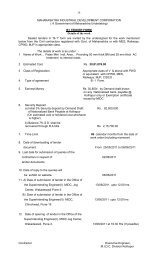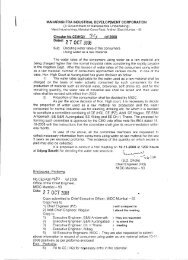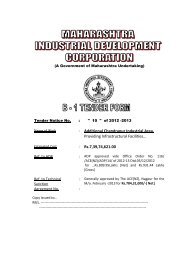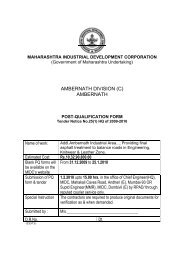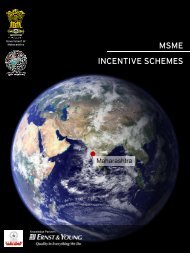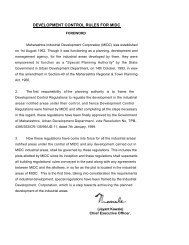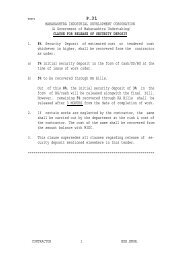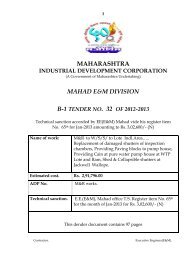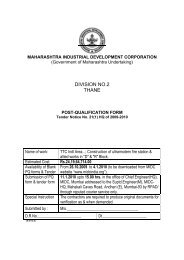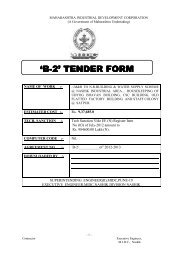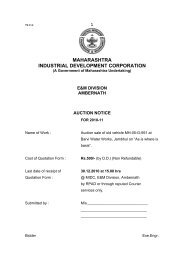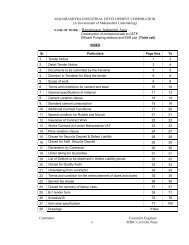Kagal-Hatkanangale Five Star Indl. Area..... Repairs and resurfac
Kagal-Hatkanangale Five Star Indl. Area..... Repairs and resurfac
Kagal-Hatkanangale Five Star Indl. Area..... Repairs and resurfac
Create successful ePaper yourself
Turn your PDF publications into a flip-book with our unique Google optimized e-Paper software.
82<br />
MAHARASHTRA INDUSTRIAL DEVELOPMENT CORPORATION<br />
( A GOVERNMENT OF MAHARASHTRA UNDERTAKING)<br />
Name of Work:- <strong>Kagal</strong>-<strong>Hatkanangale</strong> <strong>Five</strong> <strong>Star</strong> <strong>Indl</strong>. <strong>Area</strong>.....<br />
<strong>Repairs</strong> <strong>and</strong> <strong>resurfac</strong>ing of existing 4-lane approach road from<br />
NH-4 to Raymond Chowk.<br />
ITEM WISE SPECIFICATIONS<br />
Item No. 1.:- Providing <strong>and</strong> laying Lean Mix BM (LBM) using 60 / 70 grade asphalt for filling<br />
pot-holes <strong>and</strong> improvement of existing road surface wherever required including material,<br />
heating asphalt, premixing it with stone metal in hot mix paver transporting <strong>and</strong> laying, rolling<br />
<strong>and</strong> finishing etc. complete using metal grading as per Table No 500-4 of specification of road &<br />
bridges published by IRC etc. complete. (using asphalt @ 3.5% by weight of mix excluding tack<br />
coat).<br />
General : The item pertains to providing <strong>and</strong> laying lean mix BM for filling potholes <strong>and</strong><br />
improvement of existing road surface.<br />
Materials : Binder shall be as specified <strong>and</strong> shall conform to IS : 73 <strong>and</strong> stone chipping shall<br />
conform to grading as the Table below unless otherwise specified or directed by the Engineerin-Charge.<br />
The quantities of materials shall be as specified in Table below. Proper record will be<br />
kept to ensure that the daily out-turn of work is correlated with the quantity of bitumen.<br />
Materials required per cum of compacted lean asphalt mix shall be as under :- Approx.<br />
Rate of asphalt application for tack coat shall be 5 Kg./10 m2<br />
The asphalt shall be evenly spread over the surface at the rate specified. It will be further<br />
evened up by oil immersed brushes with long h<strong>and</strong>les to cover the entire surface with the<br />
asphalt.<br />
Mixing : The mixing of stone <strong>and</strong> asphalt shall be done into power driven mixer or any other<br />
suitable mixing machine, approved by the Engineer-in-Charge.<br />
Mixing shall be done till all the aggregates are thoroughly coated. The required quantity of chips<br />
for each batch of mix shall be put in the mixer through automatic arrangements provided<br />
through suitable measuring boxes of 3 Cum capacity <strong>and</strong> the required quantity of asphalt will be<br />
added properly.<br />
Laying : The premix so prepared shall be transported <strong>and</strong> laid on the road surface by means of<br />
paving <strong>and</strong> finishing machine. The carpet shall be so laid as to give desired compacted<br />
thickness. Before starting laying, tack coat shall be provided at 5 Kg/10 m2 to the cleaned old<br />
surface.<br />
The conveyance of premix from mixing plant to site of laying will not be paid extra.<br />
All the depression etc. noticed while the rolling is in progress shall be made good by adding<br />
premixed chips <strong>and</strong> rolled again. The final surface so obtained shall be as specified by the<br />
Engineer-in-Charge. 60/70 penetration grade asphalt shall be used for tack coat only.<br />
Contractor.<br />
Executive Engineer,<br />
MIDC, Division Kolhapur
Rolling :<br />
83<br />
MAHARASHTRA INDUSTRIAL DEVELOPMENT CORPORATION<br />
( A GOVERNMENT OF MAHARASHTRA UNDERTAKING)<br />
i) The premix after laying properly on the road shall be rolled with 8 to 10 tonne roller. All<br />
depressions etc. shall be made good by adding premix chips while rolling is in progress as<br />
mentioned under laying above.<br />
ii) The wheels of roller shall be wetted while rolling the premix.<br />
iii) The road may be opened to traffic after 48 hrs.<br />
Special Requirements :<br />
1. Test : Extraction test for the correct use of bitumen at the rate specified shall be done by the<br />
contractor at his own cost from the mix prepared for laying selected at r<strong>and</strong>om by the<br />
Engineerin- Charge or his representative at least 4 times a day. If the rate of bitumen specified<br />
varies, more frequent tests are to be carried out. If the bitumen is less than that specified,<br />
worked out from average of tests in a day, reduced rate will be paid. If however, the bitumen is<br />
found to be more, no extra payment shall be made since the contractor is supposed to use<br />
exact quantity of bitumen as specified.<br />
2. Analysis of each type of aggregate as specified shall be made. If the material do not run<br />
uniform, more frequent test shall be carried out.<br />
3. Arrangement for carrying out these two tests shall be made by the contractor at of the work<br />
at his own cost to exercise proper control over the preparation of aggregate <strong>and</strong> bitumen. The<br />
tests should be carried out in the presence of the Engineer-incharge.<br />
4. Compact mix density shall have equal to or greater than 95 of laboratory specimen grade in<br />
the given proportion.<br />
5. In order to check the average thickness, trial area shall be laid with a known weight of<br />
material in order to determine the area covered per tonne <strong>and</strong> daily check shall be made on the<br />
average obtained with the assessed daily tonnage laid.<br />
6. The item covers filling pot holes on the existing asphalt surface to make true to slope <strong>and</strong><br />
gradient of the surrounding road surface.<br />
Mode of Measurement <strong>and</strong> Payment : The actual consolidated volume of lean Mix/Bituminous<br />
Macadam shall be paid for. The rate shall be for one cubic meter of compacted L.B.M. as per<br />
specification. Trial will be taken to check up the percentage reduction in volume after<br />
consolidation to determine the actual quantity for payment. For calculation, average depth of the<br />
pot holes <strong>and</strong> its area will be measured. No payment for tack coat is payable as it is included in<br />
the item itself.<br />
Item No. 2.:- Cleaning the old / fresh asphalt surface with wire brushes, bristles brushes <strong>and</strong><br />
gunny bags to receive asphalt treatment.<br />
General : The item provides cleaning the old or fresh asphalt surface with wire bristle brush <strong>and</strong><br />
with gunny bags before applying new asphalt treatment.<br />
Equipment : The equipment such as small pick wire bristle brushes <strong>and</strong> gunny bags shall be<br />
used for cleaning.<br />
Cleaning : Prior to the application of the binder, all dust, dirt, caked mud, animal dung, loose<br />
<strong>and</strong> foreign material etc. shall be removed 30 cm on either side, beyond the full width to be<br />
treated, by means of mechanical sweepers <strong>and</strong> blowers, if available or other wise with wire<br />
brushes, small picks, brooms etc. the material so removed shall be disposed off as directed by<br />
Contractor.<br />
Executive Engineer,<br />
MIDC, Division Kolhapur
84<br />
MAHARASHTRA INDUSTRIAL DEVELOPMENT CORPORATION<br />
( A GOVERNMENT OF MAHARASHTRA UNDERTAKING)<br />
the Engineer-in-charge. The prepared surface shall be closed to traffic <strong>and</strong> maintained fully<br />
clean till the binder is applied.<br />
Item to Include : The item includes all labour, equipment etc. required for cleaning the old or<br />
fresh asphalt road surface as per above specifications.<br />
Mode of Measurement <strong>and</strong> Payment : The area of old or fresh asphalt road thus cleaned as<br />
per the above specifications shall be measured in sqm. The contract rate shall be per sqm of<br />
asphalt road cleaned.<br />
Item No. 3:- Providing <strong>and</strong> laying premixed bituminous macadam using 60 / 70 grade asphalt<br />
including all materials, heating bitumen, premixing it with stone metal, in a hot mix plant,<br />
transporting, laying the mix with hydrostatic paver with sensor control <strong>and</strong> compacting with<br />
smooth wheeled t<strong>and</strong>em vibratory roller, including initial cleaning of surface, tack coat using 80<br />
/ 100 grade asphalt or bituminous emulsion etc. complete. Including all leads <strong>and</strong> lifts. (Asphalt<br />
to be used at 4.35% by weight of total mix).<br />
A) By using penetration grade bitumen conforming to IS 73-1992 for tack coat<br />
a) 50 mm compacted thick with heating aggregate<br />
The work shall be carried out as per MOST specification Item No. 504.<br />
General:- The work shall consist of construction in a single course of compacted crushed<br />
aggregate premixed with a bituminous binder, to serve as base/binder course, laid immediately<br />
after mixing on a base prepared previously in accordance with the requirement of these<br />
specifications <strong>and</strong> in conformity with the lines grade <strong>and</strong> cross-sections shown on the drawing<br />
or as directed by the Engineer-In-Charge.<br />
Material:-<br />
Bitumen:- The bitumen shall be paving bitumen of 60/70 penetration grade as per IS:73-1992.<br />
Aggregates:- The aggregates shall consist of crushed stone, crushed gravel/shingle or other<br />
stones, they shall be clean, strong, durable, fairly cubical shape <strong>and</strong> free from disintegrated<br />
pieces, organic or other deleterious matter <strong>and</strong> adherent coating. If crushed shingle/gravel is<br />
used not less than 90 percent by weight of the gravel/shingle pieces retained on 4.75mm sieve<br />
shall preferably be hydrophobic <strong>and</strong> of low porosity. The aggregates shall satisfy the physical<br />
requirements set forth in table 500-3.<br />
PHYSICAL REQUIREMENTS OF AGGREGATES FOR BITUMINOUS MACADAM.<br />
Sr.<br />
Test Test Method Requirement<br />
No.<br />
1 Loss Angeles Abrasion Value* Is:2386 (Part-4) 40 % Max<br />
2 Aggregate Impact Value* ---do--- 30% Max<br />
3 Flakiness <strong>and</strong> Elongation Indices (Total) IS:2386 (Part-1) 30% Max<br />
4 Coating <strong>and</strong> stripping of bitumen ASSHTO T-182 Minimum retained<br />
aggregate Mixtures<br />
coating 95%<br />
Contractor.<br />
Executive Engineer,<br />
MIDC, Division Kolhapur
5 Soundness:<br />
85<br />
MAHARASHTRA INDUSTRIAL DEVELOPMENT CORPORATION<br />
( A GOVERNMENT OF MAHARASHTRA UNDERTAKING)<br />
i) Loss with sodium sulphate 5<br />
cycle<br />
ii) Loss with magnesium<br />
sulphate 5 cycles<br />
IS:2386<br />
(Part-5)<br />
12 % Max<br />
18 % Max<br />
6 Water absorption IS:2386(Part-3) 2 percent Max<br />
* Aggregates may satisfy requirement for either of the two tests.<br />
The aggregate for bituminous macadam shall conform to the grading given in table below:-<br />
AGGREGATE GRADING FOR BITUMINOUS MACADAM<br />
Is Sieve Designation Percent by weight passing the sieve<br />
Grading –2<br />
26.50 mm 100%<br />
19.0 mm 90 to 100%<br />
13.20 mm 56 to 88%<br />
4.75 mm 16 to 36%<br />
2.36mm 4 to 19%<br />
0.30mm 2 to 10%<br />
75 micron 0 to 8%<br />
The maximum compacted thickness of layer shall not more than 100 mm.<br />
The quantities of aggregates to be used shall be sufficient to yield the specified thickness after<br />
compaction.<br />
Proportioning of Materials:- The bitumen content for premixing shall be 4.35% by weight of<br />
the total mix except otherwise directed by the Engineer.<br />
Variation in Proportioning of Material:- The contractor shall have the responsibility for<br />
ensuring proper proportioning of materials <strong>and</strong> producing uniform mix. A variation in binder<br />
content + 0.30 % by weight of total mix shall however, be permissible for individual specimens<br />
taken for quality control test.<br />
Construction Operations:-<br />
Weather <strong>and</strong> seasonal Limitations:- The work of laying shall not be taken up during rainy or<br />
foggy weather or when the base course is damp or wet, or during dust storm or when the<br />
atmospheric temperature in shade is 10ºc or less.<br />
Preparation of the base:- The base on which bituminous macadam is to be laid shall be<br />
prepared, shaped <strong>and</strong> conditioned to the specified lines, grade <strong>and</strong> cross-sections in<br />
accordance with clause 501. <strong>and</strong> a priming coat where needed shall be applied in accordance<br />
with clause 502 as directed by the Engineer.<br />
Tack Coat:- A tack coat at the rate of 5 Kg/10m2 & as per clause 503 shall be applied over the<br />
base.<br />
Preparation <strong>and</strong> Transport of Mix:- Bituminous macadam mix shall be prepared in a hot mix<br />
plant of adequate capacity <strong>and</strong> capable of yielding a mix of proper <strong>and</strong> uniform quality with<br />
thoroughly coated aggregates. The plant shall have co-ordinate set of essential units capable of<br />
producing uniform mix within the job mix formula. The temperature of binder at the time of<br />
Contractor.<br />
Executive Engineer,<br />
MIDC, Division Kolhapur
86<br />
MAHARASHTRA INDUSTRIAL DEVELOPMENT CORPORATION<br />
( A GOVERNMENT OF MAHARASHTRA UNDERTAKING)<br />
mixing shall be in the range of 150ºc- 160ºc provided that the difference in temperature between<br />
the binder <strong>and</strong> aggregate at no time exceeds 140ºc Mixing shall be through to ensure that a<br />
homogeneous mixture is obtained in which all particles of the aggregates are coated uniformly<br />
<strong>and</strong> the discharge temperature of mix shall be between 130ºc to 160 ºc.The mixture shall be<br />
transported from the mixing plant to the point of use in suitable tipper vehicles. The vehicles<br />
employed for transport shall be clean <strong>and</strong> be covered in transit it so directed by the Engineer.<br />
Any tipper causing excessive segregation of materials by its spring suspension or other<br />
contribution factors of that which show undue delay shall be removed from the work until such<br />
conditions are corrected.<br />
Spreading:-<br />
The mix transferred from the tipper at site to the paver shall be spread<br />
immediately by means of sensor paver with suitable screeds capable of spreading, tamping,<br />
<strong>and</strong> finishing the mix true to the specified lines, grades <strong>and</strong> cross sections. The sensor paver<br />
finisher shall have the following essential features.<br />
a) Loading hopers <strong>and</strong> suitable distributing mechanism.<br />
b) All drive having hydrostatic drive/control.<br />
c) The machine shall have a hydraulically extendable screed for appropriate width requirement.<br />
d) The screed shall have tamping <strong>and</strong> vibrating arrangement for initial compaction to the layer<br />
as it is spread without rutting or otherwise marring the surface.<br />
amplitude <strong>and</strong> variable frequency.<br />
It shall have adjustable<br />
e) The sensor paver shall be equipped with an electronic sensing device for automatic leveling<br />
<strong>and</strong> profile control within the specified tolerances.<br />
g) The screed shall have the internal heating arrangement.<br />
h) The sensor paver shall be capable of laying either 4.0 to 7.50m width as stipulated in the<br />
contract.<br />
i) The sensor paver shall be so designed as to eliminate skidding/slippage of the tyres during<br />
operation.<br />
No work of BM or AC shall be allowed in failure of screed vibrating arrangement <strong>and</strong> electronic<br />
sensing device.<br />
The temperature of the mix at the time of laying shall be in the range of 120ºc to<br />
160ºc. In multi layer construction, the longitudinal joint in one layer shall offset that in the layer<br />
below by about 150mm. However, the joint in the top-most layer shall be at the lane line of the<br />
pavement.<br />
Longitudinal joints <strong>and</strong> edges shall be constructed true to the delineating line<br />
parallel to the centre of the road. All joints shall be cut vertical to the full thickness of the<br />
previously laid mix <strong>and</strong> the surface painted with hot bitumen before placing fresh material.<br />
Longitudinal <strong>and</strong> transverse joints shall be offset by at least 250mm from those in the lower<br />
course <strong>and</strong> the joints on the top most layer shall not be allowed to fall within the wheel patch.<br />
All transverse joints shall be cut vertically to the full thickness of the previously laid mix with<br />
asphalt cutter/pavement breaker <strong>and</strong> surface painted with hot bitumen before placing fresh<br />
material. Longitudinal joints shall be preferably hot joints. Cold longitudinal joints shall be<br />
properly heated with joint heater to attain a suitable temperature of about 80ºc before laying of<br />
adjacent material.<br />
Compaction:- After spreading of mix, rolling shall be done by vibratory compactors having 30<br />
MT vibrating capacity Rolling shall start as soon as possible after the material has been spread<br />
Contractor.<br />
Executive Engineer,<br />
MIDC, Division Kolhapur
87<br />
MAHARASHTRA INDUSTRIAL DEVELOPMENT CORPORATION<br />
( A GOVERNMENT OF MAHARASHTRA UNDERTAKING)<br />
deploying a set of rollers as the rolling is to be completed in limited time frame. The roller shall<br />
move at a speed shall be between 3.5 to 4 km/hour. Rolling shall be done with care to avoid<br />
unduly roughening of the pavement surface.Rolling of the longitudinal joints shall be done<br />
immediately behind the paving operation. After this, the rolling shall commence at the edges<br />
<strong>and</strong> progress towards the centre longitudinally except that on super elevated <strong>and</strong> uni-directional<br />
cambered portions, it shall progress from the lower to the upper edge parallel to the centre line<br />
of the pavement.The initial or break-down rolling shall be done with 8/10 MT static weight<br />
smooth wheel roller(3 wheels or t<strong>and</strong>em) as soon as it is possible to roll the mix without<br />
cracking the surface or having the mix pickup on the roller wheels. The second or intermediate<br />
rolling shall follow the break-down rolling with vibratory compactor having 30 MT vibrating<br />
capacity & following to the paver <strong>and</strong> be done while the paving mix is still at a temperature that<br />
shall result in maximum density. The final rolling shall be done while material is still workable<br />
enough for removal of roller marks with vibratory roller. During the final rolling, vibratory system<br />
shall be switched off. The joints <strong>and</strong> edges shall be rolled with at 8 to 10 tonne static roller.<br />
When the roller has passed over the whole area once, any high spots or depressions which<br />
become apparent shall be corrected by removing or adding mix material. The rolling shall then<br />
be continued till the entire surface has been rolled to 95% of the average laboratory density<br />
(obtained from Marshall specimens compacted as defined in Table 500-10) there is no crushing<br />
of aggregates <strong>and</strong> all roller marks have been eliminated. Each pass of the roller shall uniformly<br />
overlap not less than one-third of the track made in the preceding pass. The roller wheel shall<br />
be kept damp if necessary to avoid bituminous material from sticking to the wheels <strong>and</strong> being<br />
picked up. In no case shall fuel, lubrication oil be used for this purpose, nor excessive water<br />
poured on the wheels. The roller should have mechanical, water sprinkler for keeping the<br />
wheels damp. Rolling operations shall be completed in every respect before the temperature of<br />
the mix fails below 100ºc. Roller(s) shall not st<strong>and</strong> on newly laid material while there is a risk<br />
that surface shall be deformed thereby. The edges along <strong>and</strong> transverse of the bituminous<br />
macadam laid <strong>and</strong> compacted earlier shall be cut to their full depth so as to expose fresh<br />
surface which shall be painted with a thin surface coat of appropriate binder before the new mix<br />
is placed against it.<br />
Surface Finish <strong>and</strong> Quality control of work:-<br />
The surface finish of construction shall conform to the requirement of clause 902. Control on<br />
the quality of materials <strong>and</strong> works shall be exercised by the Engineer in accordance with section<br />
900.<br />
Arrangement of Traffic.:-<br />
During the period of construction, arrangement of traffic shall be done to clause 112.<br />
Item to Include:-<br />
The contract unit rate for the work shall be payment in full for carrying out the required<br />
operations including full compensation for<br />
i) Making arrangements for traffic to clause 112 except for initial treatment to verge shoulders<br />
<strong>and</strong> construction of diversions.<br />
ii) Preparation of base for laying of profile corrective course but including filling of potholes.<br />
iii) Providing all materials to be incorporated in the work including arrangement for stock yards,<br />
all royalties, fees, rents where necessary <strong>and</strong> all leads <strong>and</strong> lifts.<br />
Contractor.<br />
Executive Engineer,<br />
MIDC, Division Kolhapur
88<br />
MAHARASHTRA INDUSTRIAL DEVELOPMENT CORPORATION<br />
( A GOVERNMENT OF MAHARASHTRA UNDERTAKING)<br />
iv) All labour, tools equipment plant including installation of hot mix plant , power supply units<br />
<strong>and</strong> all machineries incidental to complete the work of the specifications.<br />
v) Carrying out the work in part widths of the road where directed.<br />
vi) Carrying out all tests for control of quality <strong>and</strong><br />
vii) The rate shall cover the provision of bitumen at 4.35% of weight of total mix. Variation of<br />
quantity of bitumen @ + 5% tolerance shall be permitted.<br />
asphalt/bitumen no extra payment shall be considered.<br />
However for excess use of<br />
viii) The item includes the tack coat at 5 Kg/10M2 grade of bitumen S-90 i.e. 80/100 penetration.<br />
No extra payment shall be considered for tack coat.<br />
Mode of Measurement &Payment:- The BM of specified thickness shall be measured as<br />
finished work in square meter. The contract rate shall be paid on basis of sq.m.<br />
Item No. 4.:- Providing <strong>and</strong> laying hot mix, hot laid premixed bituminous concrete using 60 / 70<br />
grade asphalt/ CRMB/PMB including all materials, heating aggregate, asphalt etc. <strong>and</strong> mixing in<br />
hot mix plant, transporting laying with hydrostatic paver, finished with sensor control compacting<br />
<strong>and</strong> rolling with smooth wheeled t<strong>and</strong>em vibratory roller. Asphalt to be used at 6.25% by weight<br />
of total mix (machine laid only) & tack coat at 5 kg/10m2.<br />
A) Using 60/70 grade Asphalt<br />
a) 25 mm thick (for wearing course)<br />
The work shall be carried out as per MOST Specification No. 512.<br />
General:- This work shall consist of constructing in a single layer, bituminous concrete<br />
(asphaltic concrete) of thickness 25 on previously prepared bituminous course to the<br />
requirements of these specifications to save as weaving course.<br />
Materials : Bitumen :-<br />
The bitumen shall be paving bitumen of suitable penetration grade 30/40 or 60/70 as per Indian<br />
st<strong>and</strong>ard Specification for “ Paving Bitumen” IS: 73-1961.<br />
Course Aggregates :- The aggregates shall consist of crushed stone, crushed gravel/shingles<br />
or other stones. They shall be clean, strong , durable <strong>and</strong> fairly cubical in shape <strong>and</strong> free from<br />
disintegrated pieces, organic or other delirious matter <strong>and</strong> adherent coating. The aggregate<br />
shall satisfy the physical requirement as per Table below.<br />
Table<br />
PHYSICAL REQUIREMENTS FOR COARSE AGGREGATE FOR BITUMINOUS<br />
CONCRETE PABEMENT LAYERS<br />
Property Test Specification<br />
Cleanliness Grain size analysis¹<br />
Max 5% passing 0.075mm sieve<br />
(dust)<br />
Max 30% (combined)²<br />
Flakiness <strong>and</strong> Elongation Max 30%<br />
Particle shape Index<br />
Max 24% Min 55%<br />
Strength* Los Angeles Abrasion Value³ Max 12%<br />
Polishing Aggregate Impact value Max 18%<br />
Durability Polished stone value<br />
Max 2 %<br />
Soundness<br />
Minimum Retained<br />
Sodium sulphate<br />
Contractor.<br />
Executive Engineer,<br />
MIDC, Division Kolhapur
Water absorption<br />
Stripping<br />
Water<br />
sensitivity**<br />
89<br />
MAHARASHTRA INDUSTRIAL DEVELOPMENT CORPORATION<br />
( A GOVERNMENT OF MAHARASHTRA UNDERTAKING)<br />
Magnesium Sulphate<br />
Water absorption<br />
Coating <strong>and</strong> stripping of<br />
Bitumen aggregate Mixtures<br />
Retained Tensile strength<br />
coating 95%<br />
Min 80%<br />
Notes:- 1. IS: 2386 Part I 6. IS : 2386 part 5<br />
2. IS:2386 Part II 7 IS: 2386 Part 3<br />
(The elongation test to be done only on non flaky aggregates in the sample)<br />
3. IS: 2386 Part 4* 8 AASHTO T283**<br />
4 IS: 2386 Part 4* 9 IS: 6241<br />
5 BS: 812 Part 114<br />
* Aggregate may satisfy requirements of either of the tests.<br />
** Elongation index is wt. of elongated particles divided by no flaky particles. They value of<br />
flakiness index <strong>and</strong> elongation index so found are added for total Flakiness <strong>and</strong> elongation<br />
indexes.<br />
Fine Aggregates :-<br />
Fine aggregates shall be the fraction passing 2.36 mm sieve <strong>and</strong> retained on 75 micron sieve,<br />
consisting of crusher run screenings, natural s<strong>and</strong> or a mixture of both. These shall be clean,<br />
hard, durable, uncoated, dry <strong>and</strong> free from any injurious soft pieces <strong>and</strong> organic or other<br />
deleterious substances.<br />
Filler :-<br />
Filler shall consist of finely divided mineral matter such as rock dust, hydrated lime or cement as<br />
approved by the Engineer-In-charge. The filler shall be graded within the following limits as per<br />
Table below. The filler shall be free from organic impurities <strong>and</strong> have a plasticity index not grater<br />
than 4. The plasticity index requirement shall not apply if filler is cement or lime.<br />
Aggregates gradation :-<br />
The material aggregates, including mineral filler shall be so blended or combined as to confirm<br />
to the grading set forth in Table below. The grading shall be decided by the Engineer-In-Charge<br />
during execution of work at site.<br />
COMPOSITION OF BITUMINOUS CONCRETE<br />
PAVEMENT LAYERS<br />
Grading 1<br />
Nominal aggregate size<br />
13 mm<br />
Layer Thickness<br />
30-45mm<br />
IS Sieve(mm)<br />
45<br />
37.5<br />
26.50 100<br />
19.00 79-100<br />
9.50 70-88<br />
4.75 53-71<br />
2.36 42 - 58<br />
1.18 34-48<br />
Contractor.<br />
Executive Engineer,<br />
MIDC, Division Kolhapur
90<br />
MAHARASHTRA INDUSTRIAL DEVELOPMENT CORPORATION<br />
( A GOVERNMENT OF MAHARASHTRA UNDERTAKING)<br />
0.60 26-38<br />
0.30 18-28<br />
0.15 12-20<br />
0.075 4-10<br />
Mix Design :<br />
512.3.1Requirement of Mix :- Apart from conformity with the grading <strong>and</strong> quality requirements<br />
of individual ingredients, the mix shall meet the requirements set forth in Table below<br />
TABLE<br />
REQUIREMENTS OF BITUMINOUS CONCRETE<br />
Sr. Item Description<br />
Requirements.<br />
No.<br />
1. Marshall stability (ASTM designation D-1559) 820 Kg<br />
determined on marshal specimens compacted<br />
by 75 compaction blows on each face.<br />
2. Marshall flow (mm) Minimum 2<br />
3. Marshall flow (mm) 2– 4<br />
4. Maximum flow 4<br />
5. Percent air voids in mix 3-5<br />
6. Minimum percent voids in mineral aggregates 10 - 12<br />
7. Binder content percent by weight of total mix 6.25%<br />
8. Percent voids in mineral aggregate filled by 65-75<br />
bitumen<br />
9 Minimum stability (KN at 60 C) 9-0<br />
Binder Content :- The binder content shall be so fixed as to achieve the requirement of the mix<br />
se forth in Table 500-24. Marshall method for arriving at the binder content shall be adopted.<br />
Job mix formula :-<br />
The contractor shall intimate to the Engineer-In-Charge in writing, at least 20 days before the<br />
start of the work, the job mix formula proposed to be used for the work <strong>and</strong> shall give the<br />
following details:-<br />
a. Source <strong>and</strong> location of all materials.<br />
b. Proportions of all materials expressed as follows where each is applicable.<br />
Binder bitumen 6.25 % - As percentage by weight of total mix.<br />
Coarse aggregate<br />
-As percentage by weight of total aggregate.<br />
Fine aggregate<br />
-Including mineral filler.<br />
c. A single definite percentage passing each sieve for the mixed aggregate.<br />
d. The results of test enumerated in table as obtained by the contractor.<br />
e. Test results of physical characteristics of aggregates to be used.<br />
f. Mixing <strong>and</strong> compacting temperature.<br />
Contractor.<br />
Executive Engineer,<br />
MIDC, Division Kolhapur
91<br />
MAHARASHTRA INDUSTRIAL DEVELOPMENT CORPORATION<br />
( A GOVERNMENT OF MAHARASHTRA UNDERTAKING)<br />
While working out the job mix formula, the contractor shall ensure that it is based on as correct<br />
<strong>and</strong> truly representative sample of the material that shall be used actually in the work <strong>and</strong> that<br />
the mix <strong>and</strong> its ingredients satisfy the physical <strong>and</strong> strength requirements of these<br />
specifications.<br />
Approval of the job mix formula shall be based on independent testing by the Engineer-In-<br />
Charge for which sample of all in ingredients of the mix shall be furnished by the contractor as<br />
required.<br />
The approved job mix formula shall remain effective unless <strong>and</strong> until modified by the Engineer-<br />
In-Charge. should a change in the source of materials be proposed, a new job mix formula shall<br />
be established <strong>and</strong> got approved from the Engineer-In-Charge before actually using the mix <strong>and</strong><br />
materials.<br />
Permissible Variation from the Job mix formula :-<br />
The concrete shall have the responsibility of ensuring proper proportioning of materials in<br />
accordance with the approved job mix formula <strong>and</strong> producing a uniform mix. The permissible<br />
variations of individual percentage of various ingredients in the actual mix from the job mix<br />
formula may be within the limits as specified in Table 500-11. These variations are intended to<br />
apply to individual specimens taken for quality control tests.<br />
Sr.<br />
No.<br />
Description<br />
Permissible Variations<br />
1 Aggregate passing 19mm sieve or large + 8 % + 7%<br />
2 Aggregate passing 13.2mm + 7 % + 6%<br />
3 Aggregate passing 4.75mm + 6 % + 5%<br />
4 Aggregate passing 2.36mm, 1.18mm,0.6mm + 5 % + 4%<br />
5 Aggregate passing 0.3m,0.15 + 4 % + 3%<br />
6 Aggregate passing 0.075mm + 2 % + 1.5%<br />
7 Binder content + 0.3 % + 0.3%<br />
8 Mixing temperature + 10º c + 10º c<br />
Construction operation :-<br />
Weather <strong>and</strong> seasonal limitations :-<br />
The work of laying shall not be taken up during rainy or foggy weather, when the base course is<br />
damp or wet, during dust storm or when the atmospheric temperature in shade is 10º c or less.<br />
Preparation of base :- The base on which bituminous concrete is to be laid shall be prepared,<br />
shaped <strong>and</strong> conditioned to the specified levels, grade <strong>and</strong> cross fall (camber) in accordance<br />
with specifications or as directed by the Engineer-In-Charge.<br />
The surface shall be thoroughly swept clean free from dust <strong>and</strong> foreign mater using mechanical<br />
broom <strong>and</strong> dust removed by mechanical means or blown off by compressed air. In portions<br />
where mechanical means cannot reach, other approved method shall be used as directed by<br />
the Engineer-In-Charge.<br />
Tack coat :- The tack coat @ 5 kg /10sqm shall be applied over the base prepared for laying of<br />
A.C. The item includes the tack coat. No separate payment will be made for tack coat.<br />
Contractor.<br />
Executive Engineer,<br />
MIDC, Division Kolhapur
92<br />
MAHARASHTRA INDUSTRIAL DEVELOPMENT CORPORATION<br />
( A GOVERNMENT OF MAHARASHTRA UNDERTAKING)<br />
Preparation of mix :- Hot mix plant of adequate capacity <strong>and</strong> capable of producing a proper<br />
<strong>and</strong> uniform quality mix shall be used for preparing the mix. The plant may be either a batch<br />
type or continuous or drum type. The plant shall have the following essential features:<br />
A. General:-<br />
a. The plant shall have co-ordinate set of essential units capable of producing uniform mix as<br />
per the job mix formula.<br />
b. Cold aggregate feed system with minimum 3 bins having belt conveyor arrangement for initial<br />
proportioning of aggregate from each bin in the required quantities.<br />
c. Dryer unit with burner capable of heating the aggregate to the required temperature without<br />
any visible unburnt fuel or carbon residue on the aggregate <strong>and</strong> to reduce the moisture content<br />
of the aggregate to the specified minimum.<br />
d. The plant shall be fitted with suitable type of thermometer at appropriate locations o as to<br />
indicate or record/register the temperature of heated aggregate, bitumen <strong>and</strong> mix.<br />
e. Bitumen storage unit capable of heating, measuring/metering <strong>and</strong> spraying of bitumen at<br />
specified temperature with automatic synchronization of bitumen <strong>and</strong> aggregate feed in the<br />
required proportion.<br />
f. A filler system suitable to receive bagged or bulk supply of filler material <strong>and</strong> its incorporation<br />
to the mix in the correct quantity/percentage.<br />
g. A suitable built in dust control system for the dryer to contain/recycle permissible quantity of<br />
fines into the mix. It should be capable of preventing the exhaust of fine dust into atmosphere<br />
for environmental control.<br />
h. The plant should have centralized control panel/cabin capable of presenting,<br />
controlling/synchronizing all operation starting from feeding of cold aggregates to the discharge<br />
of the hot mix to ensure proper quality of mix. If should have indicators for any malfunctioning in<br />
the operation.<br />
B. For Batch Type Plant.<br />
a. Gradation control unit having vibratory screens for accurate sizing of hot aggregate <strong>and</strong><br />
storing them in separate bins.<br />
b. Proper arrangement of accurate weighing of each size of hot aggregate from the control<br />
panel before mixing.<br />
C. For continuous Type plant:-<br />
a. Gradation control unit having vibratory screens for accurate sizing of hot aggregate <strong>and</strong><br />
storing them in separate bins.<br />
b. There should be appropriate arrangement for regulating <strong>and</strong> volumetric control of the flow of<br />
hot aggregate from each bin to achieve the required proportioning.<br />
D. For Drum Mix Plant:-<br />
a. It is prerequisite that only properly screened graded material are fed to the bins. If required a<br />
vibratory screening unit should be installed at the plant site to ensure the same.<br />
b. Belt conveyors below each bin <strong>and</strong> main gathering conveyor for measuring the flow of<br />
aggregates. The temperature of binder bitumen at the time of mixing shall be in the range of<br />
150°C – 165°C <strong>and</strong> that of aggregate in the range of 155°C- 170°C provided also that at no<br />
time shall the difference in temperature between the aggregate <strong>and</strong> binder exceeds 14<br />
centigrade. The temperature of both the aggregate <strong>and</strong> the bitumen at the time of mixing shall<br />
Contractor.<br />
Executive Engineer,<br />
MIDC, Division Kolhapur
93<br />
MAHARASHTRA INDUSTRIAL DEVELOPMENT CORPORATION<br />
( A GOVERNMENT OF MAHARASHTRA UNDERTAKING)<br />
be in accordance with the job mix formula <strong>and</strong> strictly controlled. All overheated <strong>and</strong><br />
carbonized mixtures, which form or show indication of excess moisture, shall be rejected.<br />
Any truck/ tipper causing excessive segregation of material by its spring suspension or other<br />
contributing factor or that show undue delays shall be removed from the work until such<br />
condition are corrected.<br />
Spreading :- Spreading:- The mix transported from the hot mix plant to the site shall be spred<br />
by means of sensor paver with suitable screeds capable of speeding, tamping <strong>and</strong> finished the<br />
mix to specified grade, line <strong>and</strong> cross section.<br />
The paver finisher shall have the following essential features.<br />
a) Loading hoppers <strong>and</strong> suitable distributing mechanism.<br />
b) All drive having hydrostatic drive / control.<br />
c) The machine shall have a hydraulically extendible screed for appreciate width requirement.<br />
d) The screed shall have tamping <strong>and</strong> vibrating arrangement for initial compaction to the layer<br />
as it is spread without rutting or otherwise marring the surface.<br />
amplitude <strong>and</strong> frequency.<br />
It shall have adjustable<br />
e) The sensor paver shall be equipped with necessary control mechanism so as to ensure that<br />
the finished surface is free from surface blemishes.<br />
f) The sensor paver shall be fitted with electronic sensing device for automatic thickness<br />
leveling <strong>and</strong> profile control within the specified tolerance.<br />
h) The sensor shall be capable of laying either 2.5 to 4.0 m width or 4.0 to 7.0 m width as<br />
stipulated in the contract. However, in restricted locations <strong>and</strong> in narrow width where the<br />
available equipment cannot be operated the Engineer-In-Charge may permit manual laying of<br />
the mix. The Temperature of mix at the time of laying shall be in the range of 120°c – 130°c<br />
Mixes with a temperature of less that 120°C shall not be loaded into paver finisher.<br />
Longitudinal joints <strong>and</strong> edges shall be constructed true to the delineating lines parallel to the<br />
centerline of the road. Longitudinal <strong>and</strong> transverse joints shall be offset by at leas 250 mm from<br />
those in the lower course <strong>and</strong> the joints on the top most layer shall be allowed to fall within the<br />
wheel path. All transverse joints shall be cut vertically to the full thickness of the previously laid<br />
mix with pneumatic cutter <strong>and</strong> the surface painted with hot bitumen before placing fresh<br />
material. Longitudinal joints shall be preferably hot joints. Cold longitude joints shall be<br />
properly heated with joint heater to attain a suitable temperature of about 80 c before laying of<br />
any material. An overlapping of 150 mm may be allowed for making the joint.<br />
Rolling :-<br />
After spreading the mix by paver, it shall be thoroughly compacted by rolling with vibratory<br />
compactor of 30 MT capacity, moving at speed not more than 5km/hr, immediately following<br />
close to the paver. Generally the initial or breakdown rolling shall be done with 8-10 tonne static<br />
weight smooth wheeled roller. The intermediate rolling shall be done with vibratory compactor<br />
of 30 MT capacity. The finish rolling shall be done with 8 to 10 tonne Wight t<strong>and</strong>em roller. The<br />
exact pattern of rolling shall be established after trial compaction as approved by the Engineer-<br />
In-Charge. Any displacement occurring as a result of reversing the direction of a roller or from<br />
any other cause shall be corrected at once as specified <strong>and</strong>/ or removed <strong>and</strong> made good. The<br />
rollers shall not be permitted to st<strong>and</strong> on pavement which has not been fully compacted <strong>and</strong><br />
where temperature is still more than 70°C. Necessary precaution shall be taken to prevent<br />
Contractor.<br />
Executive Engineer,<br />
MIDC, Division Kolhapur
94<br />
MAHARASHTRA INDUSTRIAL DEVELOPMENT CORPORATION<br />
( A GOVERNMENT OF MAHARASHTRA UNDERTAKING)<br />
dropping of oil, grease, petrol or other foreign matter on the pavement either when the rollers<br />
are operating or st<strong>and</strong>ing.<br />
The roller wheels shall be kept moist to prevent the mix from adhering to wheels. But in no case<br />
shall fuel/lubricating oil be used for this purpose nor excessive water poured on the wheels.<br />
Rolling shall commence longitudinally from edge <strong>and</strong> proceed towards the centre, except that<br />
on portion having unidirectional cross fall/super elevation, it shall progress from the lower to<br />
upper edge parallel to the center line of the pavement. The roller shall proceed on the fresh<br />
material with rear or fixed wheel loading so as to minimize the pushing of the mix <strong>and</strong> each pass<br />
of the roller shall overlap the preceding one by half the width of the rear wheel. Rolling shall be<br />
continued till the density achieved is at least 98% of that of laboratory Marshall specimen<br />
compacted as defined in Table under 20.3.1 <strong>and</strong> all roller marks are eliminate. Patching of an<br />
area that has been rolled shall not be permitted. Rolling operations shall be completed in all<br />
respects before the temperatures of the mix falls below 100°c.<br />
Quality control Tests During construction:<br />
The material supplied <strong>and</strong> the works carried out by the contractor shall conform to the<br />
specifications prescribed in the preceding clauses. For ensuring the requisite quality of<br />
construction, the materials <strong>and</strong> works shall be subjected to quality of control tests, as described<br />
hereinafter. The testing frequencies set forth are the desirable minimum <strong>and</strong> the Engineer-In-<br />
Charge shall have the full authority to carry out additional tests as frequently as may deem<br />
necessary, to satisfy himself that the materials <strong>and</strong> works comply with the appropriate<br />
specifications. However, the number of tests recommended in tables may be reduced at the<br />
discretion of the Engineer-In-Charge if it is felt that consistency in the quality of materials can<br />
still be maintained with the reduced number or tests.<br />
Acceptance Criteria for the tests on density <strong>and</strong> Marshall stability shall be subject to the<br />
condition that the mean value is not less than specified value plus:(1.65-(1.65/(No. of sample)<br />
0.5) times the st<strong>and</strong>ard deviation.<br />
Sr. Type of<br />
No. Construction<br />
1 Dense<br />
Bitumen<br />
Macadam/se<br />
mi dense<br />
bitumen<br />
concrete.<br />
Table<br />
Minimum tests Frequently Bituminous works<br />
Tests<br />
Frequency<br />
Quality of Binder Two samples per lot to be subjected to all<br />
or some tests as directed Engineer.<br />
Aggregate Impact Value One tests per 50 m3 of aggregates<br />
Flakiness Index & --do--<br />
Elongation Index<br />
Stripping value of the Initially one set of 3 representative<br />
aggregate.<br />
specimens for each source of supply.<br />
Contractor.<br />
Executive Engineer,<br />
MIDC, Division Kolhapur
95<br />
MAHARASHTRA INDUSTRIAL DEVELOPMENT CORPORATION<br />
( A GOVERNMENT OF MAHARASHTRA UNDERTAKING)<br />
Water absorption of<br />
aggregates<br />
Stone polishing value<br />
Mix grading<br />
Stability of Mix<br />
Water sensitivity of mix<br />
(Retention of Marshall<br />
stability)<br />
Swell test on the mix.<br />
Control of binder content<br />
<strong>and</strong> gradation in the mix<br />
Rate of spread of mixed<br />
material<br />
Density of compacted<br />
layer<br />
Subsequently when<br />
warranted by changes in the quality of<br />
aggregates<br />
--do--<br />
As required for semi dense bituminous<br />
concrete/ Bituminous concrete<br />
One set of test on individual constituents<br />
<strong>and</strong> mixed aggregate from the dryer for<br />
each 40 tonnes of mix subject to a<br />
minimum of two tests per plant per day.<br />
For each 400 tonnes of mix produced, a<br />
set of 3 Marshall specimens (compacted<br />
75 blows each side) to be prepared <strong>and</strong><br />
tested for stability, flow value, density <strong>and</strong><br />
void content subject to a minimum of two<br />
sets being tested per plant per day.<br />
As required for Bituminous concrete.<br />
---do--<br />
One test for each 400 tonnes of mix<br />
subjects to a minimum of two tests per day<br />
per plant.<br />
Regular control <strong>and</strong> through checks on the<br />
weight of mixed material <strong>and</strong> layer<br />
thickness.<br />
One test per 250 m2 area.<br />
Note:- Acceptance criteria as specified or directed by Engineer-In-Charge.<br />
Item to Include:- Item includes all material, machinery, plant, tools <strong>and</strong> equipment for<br />
providing <strong>and</strong> laying hot mixed hot laid premixed bituminous concrete, of specified thickness.<br />
Mode of Measurement <strong>and</strong> payment :- Bituminous concrete shall be measured as finished<br />
work in m2 of premixed bituminous concrete laid <strong>and</strong> compacted of specified thickness.<br />
The contract rate shall be per sqm of the work executed as per above specifications.<br />
Item No. 5.:- Dismantling & removing the existing curb stone of central verge, on both sides,<br />
ends etc. & refixing the same for increasing ht of central verge by providing M-10 grade<br />
concrete for filling existing trench of curb stone, backfilling after raising ht. of central verge,<br />
including replacement of damaged curb stones by new one made from M-20 grade concrete,<br />
including cost of steel reinforcement (precast elements), providing & applying synthetic super<br />
enamel painting in two coats to central verge on both sides & top of curb stone, painting of<br />
Contractor.<br />
Executive Engineer,<br />
MIDC, Division Kolhapur
96<br />
MAHARASHTRA INDUSTRIAL DEVELOPMENT CORPORATION<br />
( A GOVERNMENT OF MAHARASHTRA UNDERTAKING)<br />
planters, raising ht. of service chambers, including replacement of damaged planters as may be<br />
required including all material, labour, watering, curing etc. complete as per detailed drawing of<br />
central verge <strong>and</strong> directions of Engineer-in-charge.<br />
Item shall generally carried out as per wording of item itself & as per relevant<br />
items of st<strong>and</strong>ard specification book of B & C Deptt. & as per direction of Engineer-in-Charge.<br />
Item includes necessary excavation or filling for pro-file correction & back filling, compaction of<br />
earthwork, curing of cement consuming items, transportation for all leads & lifts etc. complete.<br />
Mode of Measurement <strong>and</strong> payment :- The contract rate shall be per running Mtr. Basis of<br />
central verge completed satisfactorily. Contractor shall note that length of central verge will be<br />
measured only along centre line <strong>and</strong> no separate payment for curb stones on either ends will be<br />
considered.<br />
Item No. 6:- Earthwork in embankment with approved material having field soak CBR not less<br />
than 8 <strong>and</strong> laboratory soak CBR not less than 12 obtained by the Contractor from his borrow<br />
areas including all lifts <strong>and</strong> leads including laying in layers of 20cm to 30cm for power roller <strong>and</strong><br />
45cm to 60cm for vibratory compactor, breaking clods, <strong>and</strong> dressing to the required lines,<br />
curves <strong>and</strong> section including payment of royalty charges to the Govt. of Maharashtra.<br />
a) For all leads<br />
1. General:- The work shall include preliminaries of clearning site, setting out <strong>and</strong><br />
preparing the ground <strong>and</strong> thereafter, embankment for the road with approved materials<br />
obtained from sources other than Departmental l<strong>and</strong>, laying them in layers, watering<br />
<strong>and</strong> compacting to the required density lines, curves, grades, cross section <strong>and</strong><br />
dimensions shown on the plan or as directed by the Engineer-In-Charge with due<br />
allowance for shrinkage. Watering <strong>and</strong> compacting shall be paid separately under<br />
relevant items.<br />
2. Clearing Site:- The ground over which embankment is to be formed shall be cleared<br />
of all trees brushwood , loose stone, vegetation bushed, stumps <strong>and</strong> all other<br />
objectionable material under this item. Routs of trees shall be grubbed to a depth of at<br />
least 15cm. below the original ground surface <strong>and</strong> at least 30cm below the formation<br />
level whichever is deeper. The holes dug up for grubbing roots etc shall be filled with<br />
excavated material in layers of 15cms <strong>and</strong> compacted.<br />
3. Setting out- After the site is cleared setting out shall be done as laid down in<br />
specification or as directed by Engineer-In-Charge. Profiles shall be set up with setout<br />
poles to mark the centre <strong>and</strong> edges of the formation with the top levels of formation<br />
clearly marked by paint or cut <strong>and</strong> the slopes with string <strong>and</strong> pegs at every 30metres on<br />
straight portions <strong>and</strong> 10m or less on curves or as directed by the Engineer-In-charge.<br />
Toe line may be marked with pick marks. Longitudinal <strong>and</strong> cross section levels shall be<br />
taken recorded <strong>and</strong> checked for measurements <strong>and</strong> signed by the contractor or his<br />
representative.<br />
Contractor.<br />
Executive Engineer,<br />
MIDC, Division Kolhapur
97<br />
MAHARASHTRA INDUSTRIAL DEVELOPMENT CORPORATION<br />
( A GOVERNMENT OF MAHARASHTRA UNDERTAKING)<br />
All the materials <strong>and</strong> labour required for this item shall be supplied by contractor.<br />
Profiles, pages, bench marks <strong>and</strong> other markes shall be maintained without any<br />
disturbances as long as they are required.<br />
4. Materials. After utilising for the embankment all the useful <strong>and</strong> acceptable<br />
materials obtained from the road cutting within the specified leads the contractor shall<br />
obtain additional material from his borrow areas. Satisfactory soil, murum or a mixture<br />
of soil, s<strong>and</strong>, murum, gravel, small boulders or rubble shall normally be acceptable.<br />
Soils having laboratory dry density of less than1.44 gm/c.c. may not normally be used<br />
in embankments. Soils having laboratory dry density of less than 1.52 gm/c.c. may not<br />
as for as possible be used in embankments exceeding 3m in height or in embankments<br />
of any height subjected to long period of inundation. Only the materials considered<br />
suitable by the Engineer-In-Charge shall be used for the bank. Rejected materials shall<br />
not be put in to the bank nor brought to the work site. Perishable materials such as<br />
stumps pieces of wood, roots, rubbish etc. <strong>and</strong> such other materials as shall affect the<br />
stability of the embankment shall not be used. Sods with appreciable amounts of<br />
organic matter, humus or vegetation shall not be used. Soils with homes of grass shall<br />
be permitted to be used as surface covering for the side slopes to a thickness of not<br />
more than 30 cm.<br />
The material required for embankment shall be obtained in any of the following ways<br />
provided the material is suitable in the opinion of the Engineer-In-Charge.<br />
a) From cutting near by sections of the road as directed.<br />
b) From excavation for improving sight distance <strong>and</strong> road l<strong>and</strong> developments in hereby<br />
area as directed.<br />
c) By sectioning any adjacent nalla or water ways as directed.<br />
d) By excavating cuts to lead water away from the road.<br />
e) By excavating side drains <strong>and</strong> catch-water drains.<br />
f) From humps above the general ground level within the road l<strong>and</strong>.<br />
g) From l<strong>and</strong> acquired temporarily if any, outside the road l<strong>and</strong>.<br />
All lifts <strong>and</strong> leads specified for conveying the material to site<br />
shall be included in the rate except when the materials from road cutting or other excavation<br />
being paid separately are to be conveyed for use in banks with different leads under respective<br />
items.<br />
For the materials to be obtained from non-departmental <strong>and</strong> private l<strong>and</strong>s, the contractor shall<br />
make his own arrangements <strong>and</strong> be responsible for payment or rents, compensation, royalty etc<br />
<strong>and</strong> shall not be entitled for extra claims. The department shall remain indemnified regarding<br />
any claims that may be made by private owners in this respect.<br />
If all the useful materials available from the road cutting are not used <strong>and</strong> materials obtained<br />
from other sources are used instead by the contractor for his own convenience, such materials<br />
shall be deemed to have been obtained from the road cutting to the extent to which useful<br />
materials were available for bank <strong>and</strong> shall not be paid for under this item.<br />
5. Equipments Pickaxes, crowbars, pharos <strong>and</strong> pans may be used for manual work scrapers,<br />
dozers, graders, shovels, dumpers, trucks, trolleys water tanker etc. may be used for<br />
Contractor.<br />
Executive Engineer,<br />
MIDC, Division Kolhapur
98<br />
MAHARASHTRA INDUSTRIAL DEVELOPMENT CORPORATION<br />
( A GOVERNMENT OF MAHARASHTRA UNDERTAKING)<br />
mechanised work vibratory rollers with or without sheep foot giving a pressure required to obtain<br />
specified density watering <strong>and</strong> compacting is paid separately under relevant items.<br />
6. Construction Methods-<br />
1. Diversions- If diversions, barricading <strong>and</strong> signals are found to be necessary, they shall<br />
be provided as per directions of Engineer-In-Charge.<br />
2. Preparing the ground for laying bank. :- Before any materials as laid for the bank<br />
the ground shall be cleared of all rubbish etc. when the embankment is to be laid on hill<br />
sides or slopes. The existing slopes shall be ploughed deeply. If the cross slopes are<br />
sleeper than 1 in 3, steps with reverse slope shall be cut into the slopes to give proper<br />
heading <strong>and</strong> seating to the bank as directed by the Engineer-In-Charge. On surfaces<br />
flatter than 1 in 15 special surface treatment such as cutting steps shall be necessary.<br />
The top 15cm. of soil shall be scarified <strong>and</strong> watered if directed <strong>and</strong> compacted to the<br />
same density as specified for the embankment before any material is laid for the bank<br />
work.<br />
When the embankment is to be placed over an existing road or other hard surface<br />
which is within 15cm of the finished formation. The road or other hard surface shall be<br />
scarified to a minimum depth of 15 cm.<br />
The rate for embankment includes all the operations for preparing the bed for laying the<br />
bank.<br />
3. Laying the Bank:- Embankment material shall be placed in successive horizontal<br />
layers of specified depth extending to the full width of the embankment including the<br />
slopes at the levels of the particular layer <strong>and</strong> 30cm. more on both sides to allow<br />
compaction of the full specified section. The extra loose stuff at the edges shall be<br />
trimmed later after completion of the bank work without extra cost leaving the current<br />
section fully compacted.<br />
Keeping the width of the bank initially less <strong>and</strong> widening it later by dumping loose earth<br />
on the slopes shall not be permitted as the additional width <strong>and</strong> slopes shall remain<br />
loose <strong>and</strong> uncompacted. Similar procedure to extend the embankment by dumping the<br />
material longitudinally shall also not be allowed. When placing the bankwork in<br />
specified layers is not feasible as in water or over slopes too steep to operate the<br />
construction equipment the embankment may be construction in one layer to the<br />
minimum level at which equipment can be operated <strong>and</strong> above such a level, the<br />
embankment shall be made up in layers of specified thickness. When boulders, broken<br />
stones <strong>and</strong> similar hard materials are mixed up with the embankment materials care<br />
shall be taken to see that they are distributed uniformly into the bank <strong>and</strong> that no<br />
hollows are left near them. No stone or hard material shall project above the top of any<br />
layer. Each layer of embankment shall be watered, leveled <strong>and</strong> compacted as<br />
specified, before the layer is placed. The surface of the embankment shall at all times<br />
during construction, be maintained at such a cross fall as shall shed water <strong>and</strong> prevent<br />
ponding. If bridges <strong>and</strong> culverts on the road are not completed in advance of bank<br />
work, a length of 15m to 30m bank shall be left on each side of the structure <strong>and</strong> these<br />
lengths shall be depth with later for placing the bank work.<br />
Contractor.<br />
Executive Engineer,<br />
MIDC, Division Kolhapur
99<br />
MAHARASHTRA INDUSTRIAL DEVELOPMENT CORPORATION<br />
( A GOVERNMENT OF MAHARASHTRA UNDERTAKING)<br />
4. Watering <strong>and</strong> compaction:- Watering <strong>and</strong> compaction of earth work is<br />
specified under relevant item as it is to be paid separately.<br />
5. Protection:- Proper care shall be taken to ensure that the method of operation <strong>and</strong><br />
compaction of the bank work does not cause damage or under strain to any structural<br />
element. Embankment over <strong>and</strong> around bridge or culverts shall be of approved materials<br />
<strong>and</strong> carefully placed <strong>and</strong> compacted. The construction shall take all precautions necessary<br />
for the protection of the bank work by diversion of streams, local surface drainage, rain<br />
water etc. likely to damage the bank any damage to the bank work due to no protection or<br />
inadequate protection shall be made good by the contractor at his own cost. Conveyance of<br />
materials shall not cause obstruction or nuisance to the hereby property owners <strong>and</strong> traffic.<br />
6.Finishing:- The embankment shall be finished <strong>and</strong> dressed out <strong>and</strong> even to conforming<br />
with the alignment, levels cross sections <strong>and</strong> dimensions shown on the drawing with due<br />
allowance for shrinkage. On curves, sections shall be provided with super elevation <strong>and</strong><br />
increased widths as shown on the plans or directed by the Engineer-In-Charge. All<br />
damages caused by rain, flood or any other reason shall be made good in the finishing<br />
operation. The road l<strong>and</strong> width shall be cleared of all debris <strong>and</strong> ugly spots near camping<br />
areas etc. for which the contractor or his men were responsible.<br />
7. Maintenance:- The Contractor shall be responsible for maintaining the bank work<br />
satisfactorily at his own cost till finally accepted including making good any damages<br />
during defect liability period specified.<br />
Test:-<br />
a) Before murum is brought to the site, it shall be tested in laboratory for its soak CBR. In no<br />
case the laboratory soak CBR be less than 12%.<br />
b) The murum shall be tested for its liquid limit, plasticity index, maximum dry density(Proctor<br />
density) & optimum moisture content. The murum shall satisfy the requirements as listed below.<br />
i) Liquid limit Not more than 25<br />
ii) Plasticity index Not more than 6<br />
iii) Maximum dry density Not less than1.52 gm/c.c.<br />
C) When the murum is spread on site, watered & compacted for embankment, it shall be<br />
tested for field soak CBR. Field soak CBR shall be carried out at one r<strong>and</strong>om location for<br />
every 500 mtr of length of every layer of bank work. The field dry density & water content<br />
shall be tested to ascertain the field compaction for the sample from the same location for<br />
field CBR test. The field soak CBR value for murum shall not be less than 8% in any case.<br />
d) Density tests shall be carried out for the bank work during the progress of work. One set<br />
three core samples for every 1000m2 area of each layer of bank work shall be taken &<br />
tested. The average density shall not be less than 95% of proctor density for each set. All<br />
above tests shall be conducted according to IS-2720.<br />
9. Item shall include the following:-<br />
1. Clearing the site.<br />
2. Setting out alignment including necessary labour <strong>and</strong> materials <strong>and</strong> maintaining it as<br />
long as<br />
Contractor.<br />
Executive Engineer,<br />
MIDC, Division Kolhapur
equired.<br />
100<br />
MAHARASHTRA INDUSTRIAL DEVELOPMENT CORPORATION<br />
( A GOVERNMENT OF MAHARASHTRA UNDERTAKING)<br />
3. Preparing the ground for laying the embankment.<br />
4. Providing <strong>and</strong> maintaining the diversions if necessary unless provided as s separate<br />
item in the tender.<br />
5. Obtaining the embankment materials including all lifts <strong>and</strong> leads <strong>and</strong> laying the bank in<br />
layers, watering, compaction <strong>and</strong> tests, royalties fees etc. if any (Watering <strong>and</strong><br />
compaction shall be paid separately under relevant item)<br />
6. Protecting <strong>and</strong> maintaining the bank.<br />
7. Finishing the embankment.<br />
8. All labour, materials use of equipment tools <strong>and</strong> plant necessary for completing the<br />
work satisfactorily.<br />
Mode of Measurements & Payment- The contract rate shall be per cubic meter of the<br />
finished bank work, measurements shall normally be taken by leveling sections <strong>and</strong><br />
chainaging distances between them.<br />
The measurement of the sections shall be limited to the dimensions shown on the drawing<br />
or those ordered by the Engineer-In-Charge in writing. The dimensions shall be recorded<br />
correct upto two places of decimals of metre. The sectional areas shall be worked out<br />
correct upto two places of decimals of a square metre. The quantity shall be worked out<br />
correct upto two places of deceimals of a cubic metre by the average <strong>and</strong> area method.<br />
The volume of bank thus calculated shall be reduced by 16% (16 percent) for the purpose of<br />
payment when the measurements are taken for running bills <strong>and</strong> by 1% (one percent) in<br />
final measurement.<br />
If outside materials having been used in the portions of the bank work, where materials,<br />
from cutting were to be used. The outside materials shall be deemed to have been obtained<br />
from the cutting as specified in those items <strong>and</strong> paid for under those items only.<br />
The quantity payable for the bank shall be the quantity of useful road cutting materials,<br />
required to be conveyed <strong>and</strong> used within specified lead <strong>and</strong> measured in site in cutting. If<br />
the contractor for his own convenience uses materials other than these obtained form the<br />
cutting. All such materials used in place of the materials from the road cutting <strong>and</strong> paid<br />
under this item to the extent to which useful road cutting materials were available for bank<br />
within the specified lead.<br />
If a portion of the road cutting materials is ordered to be reserved for other use or rejected<br />
as not fit for bank stack measurement of reserved or rejected materials shall be reduced by<br />
adopting following percentages to arrive at compact volumes to be deducted from the total<br />
quantities of relevant excavation items to obtain the quantities put into the banks.<br />
1. Earth, soils of all sorts, s<strong>and</strong>, graval, soft murum...... 16%<br />
2. Hard murum 16%<br />
3. Boulders 40%<br />
4. Soft rock 40%<br />
5. Hard rock 40%<br />
The lead shall be reckoned along the centre of the road form the centre of mass of the road<br />
cutting to the centre of mass of embankment volume where the excavated materials have been<br />
or were to be used of the actual route of transport.<br />
Contractor.<br />
Executive Engineer,<br />
MIDC, Division Kolhapur
101<br />
MAHARASHTRA INDUSTRIAL DEVELOPMENT CORPORATION<br />
( A GOVERNMENT OF MAHARASHTRA UNDERTAKING)<br />
The quantity of bank shall be paid on the basis of quantity of road cutting used in the bank.<br />
The final quantity to be paid for under this item shall be the total quantity of bank work reduced<br />
by 1% (one percent) less than quantity to be paid for using the materials from cutting.<br />
Item No. 7.:- Watering to OMC (16 kg to 24 kg of water per Cu.M.) The earth work in<br />
embankment in 20 cm to 30 cm layers. (95% proctor density).<br />
General : The item provides watering the layers of 20 to 30 cm of embankment laid.<br />
Material <strong>and</strong> Equipment : Water to be used shall be free of harmful elements, which may<br />
cause heavy efflorescence, etc. <strong>and</strong> approved by the Engineer-in-Charge. The contractor shall<br />
make his own arrangements for getting adequate quantity of acceptable water. The water<br />
tankers shall be used, without any additional payment.<br />
Watering : When the murum of the 20 to 30 cm layer in embankment road contains less than<br />
the optimum moisture, water shall be added to the material in the embankment layers of the<br />
road to bring the moisture, uniformly up to requirement. If the material contains more than the<br />
required moisture, it shall be allowed to dry until the moisture is reduced to the required extent.<br />
If due to wet weather etc. the moisture contents of the soil cannot be reduced to the appropriate<br />
amount by exposure, the compaction shall be suspended till suitable conditions prevail without<br />
contractor’s claiming any compensation.<br />
Item to Include : All material, equipment machinery labour, taxes etc. shall be included in the<br />
rate.<br />
Mode of Measurement <strong>and</strong> Payment : The measurement shall be taken on Cum. basis of the<br />
embankment of the road watered.<br />
Item No. 8.:- Consolidation with proper ramming / rolling in layers the earth work in<br />
embankment . (95% proctor density).<br />
General : The item provides consolidation of the earthwork in embankment in 20 to 30 cm<br />
layers for 8 to 10 tonnes roller <strong>and</strong> 40 to 50 cm layers for vibratory rollers. This item is to be<br />
executed after laying the earthwork in embankment in the layers of 20 to 30 cm <strong>and</strong> the layer is<br />
watered.<br />
Equipment : The ramming rods <strong>and</strong> 8-10 tone ordinary or vibratory roller as directed shall be<br />
used.<br />
Consolidation : When a loose layer is leveled manually or mechanically with camber provided<br />
<strong>and</strong> moistened or dried to a uniform <strong>and</strong> required moisture content suitable for maximum<br />
compaction, it shall be compacted by power rollers, vibratory rollers or heavy hauling or dozing<br />
equipment to give the specified 95% of the st<strong>and</strong>ard proctor density. If on testing, the density is<br />
found to be less than 95% of the st<strong>and</strong>ard density the contractor shall do additional compaction<br />
necessary to get the specified density after adding water if required. When the specified density<br />
is imperative, the work shall be removed <strong>and</strong> redone by the contractor at his own cost to give<br />
the specified density.<br />
Proper sequence of all component operations shall be maintained to give individual progress.<br />
For compaction of embankment the road roller shall move longitudinally <strong>and</strong> rolling shall be<br />
done from edges to centre. The camber shall be provided in the cutting <strong>and</strong> shall not be<br />
Contractor.<br />
Executive Engineer,<br />
MIDC, Division Kolhapur
adjusted in metalling.<br />
102<br />
MAHARASHTRA INDUSTRIAL DEVELOPMENT CORPORATION<br />
( A GOVERNMENT OF MAHARASHTRA UNDERTAKING)<br />
Care shall be taken for getting good compaction behind abutments,<br />
returns <strong>and</strong> wing walls, etc. Cutting/ Bank-work in areas not accessible to rollers such as those<br />
adjoining bridges, culverts <strong>and</strong> other works, shall be carried out independently of the main<br />
embankment <strong>and</strong> shall have the layers placed in 10 cm to 15 cm. thickness <strong>and</strong> each layer shall<br />
be moistened <strong>and</strong> thoroughly compacted with mechanical or manual tampers. Embankment<br />
shall be brought up simultaneously in equal layers on each side <strong>and</strong> compacted carefully to<br />
avoid unequal pressure, etc<br />
The compaction of the embankment shall be done by moving road roller longitudinally from<br />
edges to centre.<br />
Item to Include : The item includes only the compaction of each layer by 8-10 tonne roller or<br />
vibratory roller. All labour <strong>and</strong> equipment required to execute the item as per above specification<br />
shall be included in the item. If specified vibratory compactors shall be used.<br />
Mode of Measurement <strong>and</strong> Payment : The measurement shall be taken of the earthwork for<br />
embankment of road in Cum. upto two decimals. The contract rate shall be for a unit of One<br />
Cubic meter of the finished bank work.<br />
Item No. 9.:- Filling in plinths <strong>and</strong> floors with hard murum brought by the contractor from his<br />
borrow areas with all leads in 150 to 200 mm layers including watering <strong>and</strong> compaction etc.<br />
complete with all leads <strong>and</strong> lifts <strong>and</strong> necessary royalty charges etc complete.<br />
General : This item includes all the leads <strong>and</strong> lifts for filling in plinth <strong>and</strong> tears with hard<br />
murum brought by the contractor from his own barrow areas. The material of filling shall be<br />
hard murum or s<strong>and</strong> <strong>and</strong> shall be got approved from the Engineer-in-charge before bringing<br />
the same at site of work for filling the plinths <strong>and</strong> floors.<br />
Material : The material brought by the contractor shall be stacked separately <strong>and</strong> classified <strong>and</strong><br />
approved, as material for filling in plinth by the Engineer-in-charge <strong>and</strong> the same, shall only be<br />
used. The stacked material shall be cleaned of all grass, vegetation <strong>and</strong> rubbish. The clods of<br />
soil shall be broken down to size below 50 mm. Black cotton soil shall never be used for filling in<br />
plinth <strong>and</strong> floor <strong>and</strong> such clods shall be removed. The material which is not approved by the<br />
Engineer-in-charge shall not be used.<br />
Method of Work : The ground between the plinth walls shall be first cleaned of all grass,<br />
rubbish etc. If directed by the Engineer-in-charge, near the sides of plinth walls special<br />
material such as specified graded murum or s<strong>and</strong> will have to be filled. The material shall be<br />
conveyed to the site <strong>and</strong> spread in 150 to 200 mm layers & shall be compacted with either<br />
manual or by mechanical means at O.M.C. for which adequate water shall be used to achieve<br />
required compaction. The procedure shall be repeated with each layer, till the required<br />
thoroughly compacted level is achieved. Care shall be taken not to damage the plinth<br />
constructions <strong>and</strong> footings below during the process of filling <strong>and</strong> compaction. The filling above<br />
decided finished level, if any, shall be scrapped <strong>and</strong> removed by the contractor at his risk <strong>and</strong><br />
cost.<br />
Filling shall be carried out for structures etc.<br />
Contractor.<br />
Executive Engineer,<br />
MIDC, Division Kolhapur
103<br />
MAHARASHTRA INDUSTRIAL DEVELOPMENT CORPORATION<br />
( A GOVERNMENT OF MAHARASHTRA UNDERTAKING)<br />
Item to Include : Cleaning of ground in plinth, cleaning of the selected<br />
material for feeling,<br />
breaking of clods, conveying <strong>and</strong> filling in the layers, watering <strong>and</strong> compaction, all labour <strong>and</strong><br />
equipments.<br />
Mode of Measurement <strong>and</strong> Payment : The measurement of the volume actually filled<br />
by the contractor encased between plinth walls shall be measured in cum without any deduction<br />
for voids. The level of the ground at all four corners <strong>and</strong> at other locations, if required for<br />
correctness, shall be recorded by the Engineer-in-charge before starting the actual filling in<br />
plinths <strong>and</strong> will be signed by the authorized representative of the contractor in token of<br />
acceptance <strong>and</strong> also by the Engineer-in-charge. Such measurements shall be recorded for each<br />
filling area separately. The average ground level shall be determined for each filling zone. The<br />
volume thus filled in <strong>and</strong> compacted as per the specifications above between the ground level<br />
<strong>and</strong> the top level shall be paid at the unit rate per cum as per the contract. The contract rate<br />
shall be per cum of work done as above.<br />
Item No. 10.:- Providing <strong>and</strong> applying of hot applied thermoplastic compound 2.5 mm thick<br />
including reflectorising glass at 250 gms per sq.m. area. Thickness of 2.5 mm is exclusive of<br />
surface applied glass beads as per ISR 035. The finished surface to be leveled uniform <strong>and</strong> free<br />
from streaks <strong>and</strong> holes including cleaning of road surface required <strong>and</strong> controlling traffic etc<br />
complete as per M.O.S.T. & H’s specification Item No 803.<br />
Specifications:-<br />
General :-<br />
The colour, width <strong>and</strong> layout of road markings shall be in accordance with the Code of<br />
Practice for road Markings with paints, IRC: 35, <strong>and</strong> as specified in the drawings or as directed<br />
by the Engineer.<br />
Hot Applied thermoplastic road marking<br />
i) The work under this section consists of marking traffic strips using a thermoplastic<br />
compound meeting the requirements specified herein.<br />
ii) The thermoplastic compound shall be screeded/extruded on to the pavement surface<br />
in a molten state by suitable machine capable of controlled preparation <strong>and</strong> laying with surface<br />
application of glass beads at a specific rate. Upon cooling to ambient pavement temperature, it<br />
shall produce an adherent pavement marking of specified thickness <strong>and</strong> width <strong>and</strong> capable of<br />
resisting deformation by traffic.<br />
iii) The colour of the compound shall be white or yellow (IS colour No. 356) as specified<br />
in the drawings or as directed by the Engineer.<br />
iv) Where the compound is to be applied to cement concrete pavement, a sealing<br />
primer as recommended by the manufacturer, shall be applied to the pavement in advance of<br />
placing of the stripes to ensure proper bonding of the compound On new concrete surface any<br />
laitance <strong>and</strong>/or curing compound shall be removed before the markings are applied. The item<br />
shall generally be Executed as per MOST Specifications section 800 clause No. 803 & to the<br />
satisfaction of Engineer In-charge.<br />
Mode of Measurement: The painted markings shall be measureted in sq. meters of<br />
actual area marked (Excluding the gaps, if any.) & payment will be made on sq.m basis.<br />
Contractor.<br />
Executive Engineer,<br />
MIDC, Division Kolhapur
104<br />
MAHARASHTRA INDUSTRIAL DEVELOPMENT CORPORATION<br />
( A GOVERNMENT OF MAHARASHTRA UNDERTAKING)<br />
Item No. 11.:- Providing <strong>and</strong> fixing of polymer shanked road studs (Reflective Pavement Market<br />
/ Cat eye) body made of tough polycarbonate of size not more than 105 x 130 x 20 mm; having<br />
reflector panel made of poly carbonate micro prismatic lens (providing total internal reflection).<br />
Electronically welded to the body. The two shanks attached with RPM to hold the marker at its<br />
place, fixed at site by drilling holes <strong>and</strong> applying high strength epoxy adhesive recommended by<br />
the manufacturer & Engineer In-charge including materials, equipment, loading, unloading etc.<br />
necessary for successful fixing as directed by Engineer-in-charge of work.<br />
Specifications :<br />
The cat eyes shall be of approved <strong>and</strong> st<strong>and</strong>ard quality of make 3M only. The reflectors shall be<br />
in coloures as specified in item. The sample shall be got approved form Engineer In-charge<br />
before procurement.<br />
Mode of measurement & payment :<br />
The contract rate shall be per No. of quantity executed as specified above.<br />
Contractor.<br />
Executive Engineer,<br />
MIDC, Division Kolhapur



